Here at Datalab, we’re often prompted to write new posts based on the insightful comments and awkward questions that readers post in the blog’s comments section. This post is actually based on my attempts to answer an awkward question from one of my Datalab colleagues, but here’s hoping it prompts even more questions and comments to keep us going with ideas for future posts.
To come to the point, I recently wrote a post that looked at the composition of MATs in terms of school phase, finding that nearly 80% of MATs are either primary-only, or a mix of mainstream phases. Secondary-only MATs make up just 5% of MATs, and there is currently only one large secondary-only MAT (that is, a MAT with ten or more open schools).
And the awkward question was: why are there so few secondary-only MATs?
We’ll be using data from Get Information about Schools from 2019-24.
Setting the scene
Let’s start with a look at the full breakdown of MATs by phase. We’re including all MATs that had at least two open schools in January 2024.

I’ve already mentioned the low proportion of secondary-only MATs. But before we move on, let’s look more closely at those MATs that include a mix of mainstream and special / AP. Could it be that there are quite a high number of trusts consisting solely of secondary schools and AP schools, for example? Perhaps the reason there are so few secondary-only MATs is that it doesn’t make sense to have a MAT that includes secondary schools but doesn’t also include AP and / or special schools?
A look at the table below answers these questions with a swift negative.

The mainstream schools in these mixed MATs tend to be either primary-only, or to include a mixture of primary and secondary schools. There are relatively few that consist solely of secondary schools and special / AP schools.
Changes over time
So back to the first question: why are there so few secondary-only MATs?
A lesser woman than me might be tempted to be flippant and say that it’s probably something to do with the fact that there are only around 3,200 state-funded secondary schools in England, while there are more than 15,000 state-funded primary schools. But I don’t think the answer’s quite as simple as that: there are 78 large primary-only MATs and just the one large secondary-only MAT, but only around five times more primary than secondary schools.
Let’s take a look at the composition of MATs over the last few years to see how much the situation has changed.
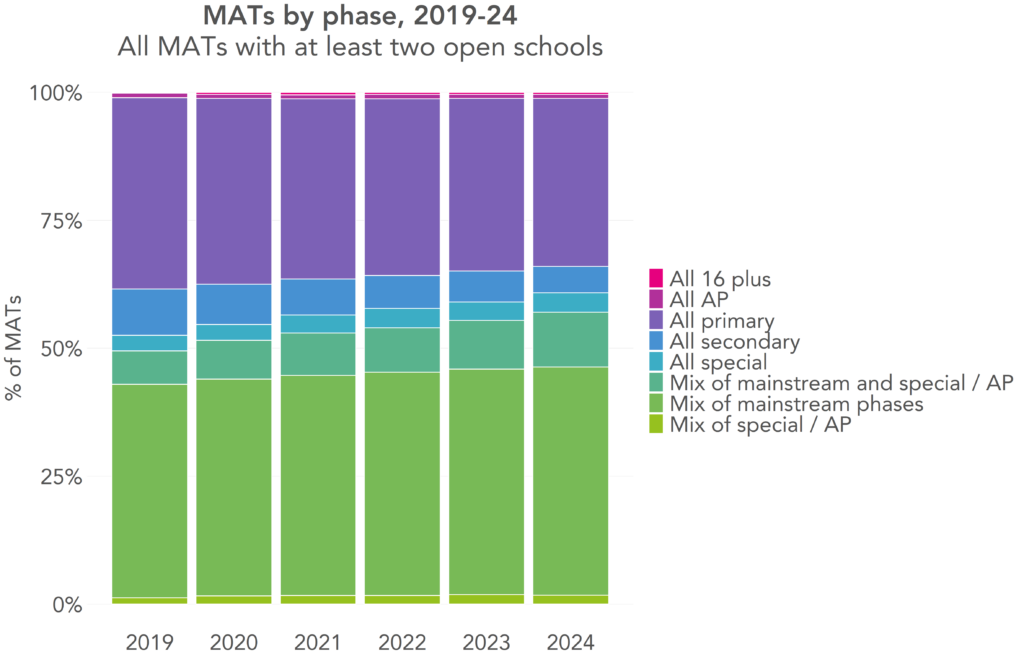
We can see that secondary-only MATs were relatively rare even back in 2019, but less so than today: they made up 9% of all MATs in 2019, compared to 5% today. The proportion of primary-only MATs has also fallen since 2019.
A closer look at the change in composition between 2019 and 2024 is given in the table below.
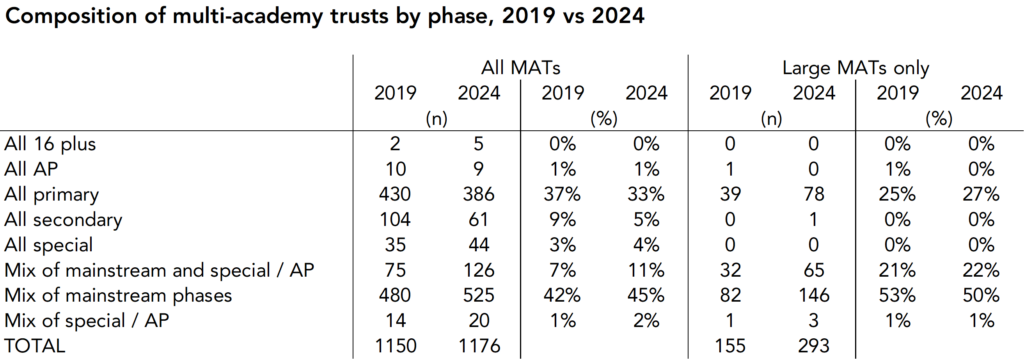
As we’ve seen, the composition of all MATs has changed since 2019: they are now less likely to be primary- or secondary-only, and more likely to include a mix of phases.
But the composition of large MATs – those with ten or more schools – actually hasn’t changed very much. What has changed is the number of large MATs: there are nearly twice as many now as in 2019.
And large MATs almost exclusively consist of either all primary schools, or a mix of phases. Secondary-only MATs, on the other hand, tend to be relatively small. In fact, more than three quarters of secondary-only MATs include just two or three schools.
What became of the smaller MATs?
We’ve seen that there are now fewer secondary-only MATs than there used to be, and also that there are now more large MATs than there used to be.
So what’s happened to the secondary-only MATs that existed in 2019? Have they expanded, taking on schools from other phases, or have they closed their doors and been replaced by new, larger MATs?
Before getting into what’s happened to secondary-only MATs specifically, let’s first look at changes for all MATs. The chart below shows how those MATs that were open in 2019 have fared since in terms of number of schools.
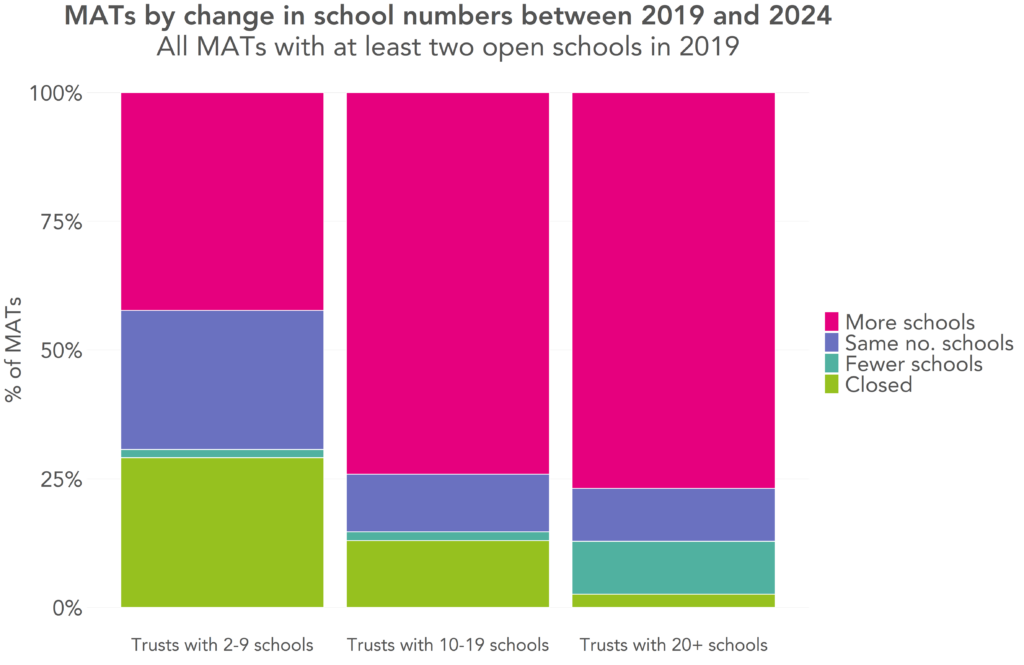
Nearly half of the MATs that existed in 2019 have since expanded, a quarter have stayed the same, and a quarter have closed. We’ve defined ‘closed’ here as MATs that no longer exist under the same name: some of these may have been renamed or merged with another trust.
A small minority have fewer schools now than in 2019. Of the more than 305 MATs that have closed, i.e. no longer exist under the same name as they did in 2019, 298 were small MATs with fewer than ten schools.
Let’s see how this breaks down for MATs that consisted of just one phase in 2019.

The picture is fairly similar for primary-only, secondary-only and special-only MATs: between 25-30% had closed by 2024, roughly half had expanded, and a minority stayed the same size or lost schools.
But we see a difference when we look at the primary-only, secondary-only and special-only MATs that did remain open until 2024. The table below compares their composition in 2024 to that in 2019.
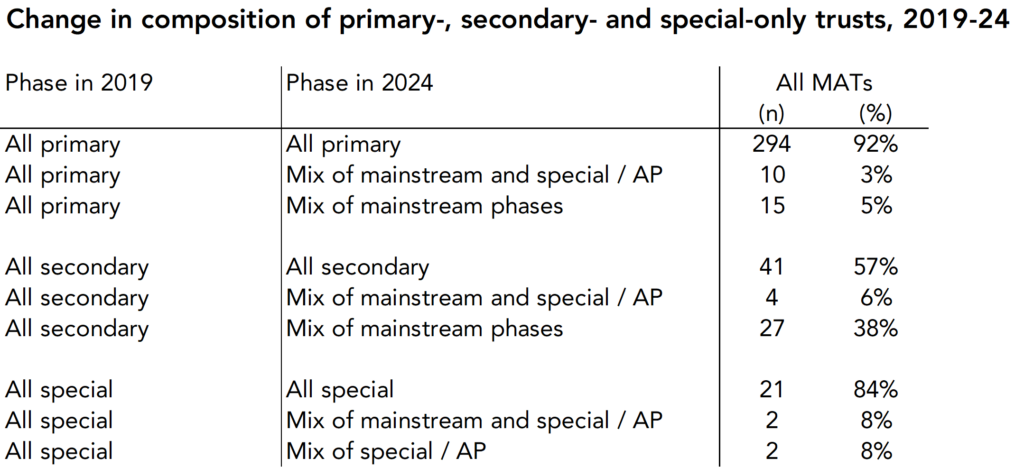
MATs that were primary-only or special-only in 2019 tended to still be primary- or special-only in 2024. But nearly half of those MATs that were secondary-only in 2019 included a mix of phases in 2024.
So it seems that when secondary-only MATs expand, they often do so by taking on schools from other phases.
Summing up
As is often the case in my posts, I haven’t really answered the question I started out with. But we have learnt some interesting things about secondary schools and MATs.
It’s relatively unusual for a secondary school to be part of a MAT that doesn’t also include some primary schools. And it’s become even more unusual over the last few years.
This seems to be connected to the tendency for MATs to get bigger: secondary-only MATs tend to be relatively small, and over the last few years smaller MATs have been quite likely to either close or expand. And when secondary-only MATs expand, it’s common for them to do so by taking on schools from other phases.
In future, we can probably expect to see the number of large MATs continue to grow, and the number of secondary-only MATs continue to shrink. We’ll also be keeping our eyes peeled to see if the number of primary-only MATs also starts to decline as MATs expand further.
Want to stay up-to-date with the latest research from FFT Education Datalab? Sign up to Datalab’s mailing list to get notifications about new blogposts, or to receive the team’s half-termly newsletter.

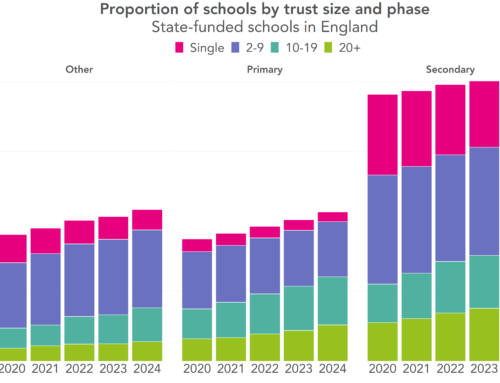

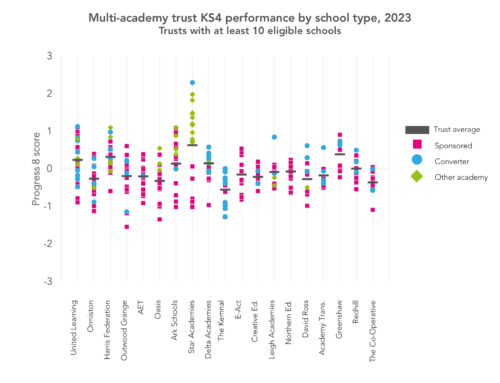

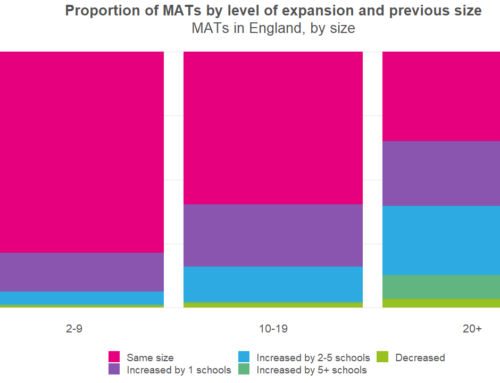
I’m guessing this is an impossible question to answer, but does the growth in the size of MATs mean that there are more corporate policies (eg a behaviour policy) that applies to all schools? Also, do your findings have any impact on tables showing which schools have excluded or suspended most children? If you are in a larger MAT do exclusions or suspensions rise, fall, or remain the same.
Good question! Based on the data we’ve got, it is impossible to say if the growth of large MATs also means more policies applied across all schools, but it does seem quite likely. The second question is even better. In one way it’s easy enough to answer – a quick bit of crunching shows that the average suspension rate for small MATs (2-9 schools) is 14.8, compared to 22.1 for large MATs. But we’d really need to get into what the figures were like for schools in large MATS *before* they joined the MAT / the MAT got larger to make it a fair comparison. Feels a bit like trying to answer the age old question about whether schools perform better in MATs or LAs.
My hypotheses to answer the question:
1) funding – given where the demographic bulges are, there are more incentives for secondary dominated MATs to add more primaries than vice versa
2) philosophical – leaders at secondary dominated MATs are impacted by decisions made at primary more than the other way round, so there is more incentive for secondary dominated MATs to branch out
Not sure either of these are testable, though I suppose survey data of MAT leadership could shed some light on it (especially point 2)